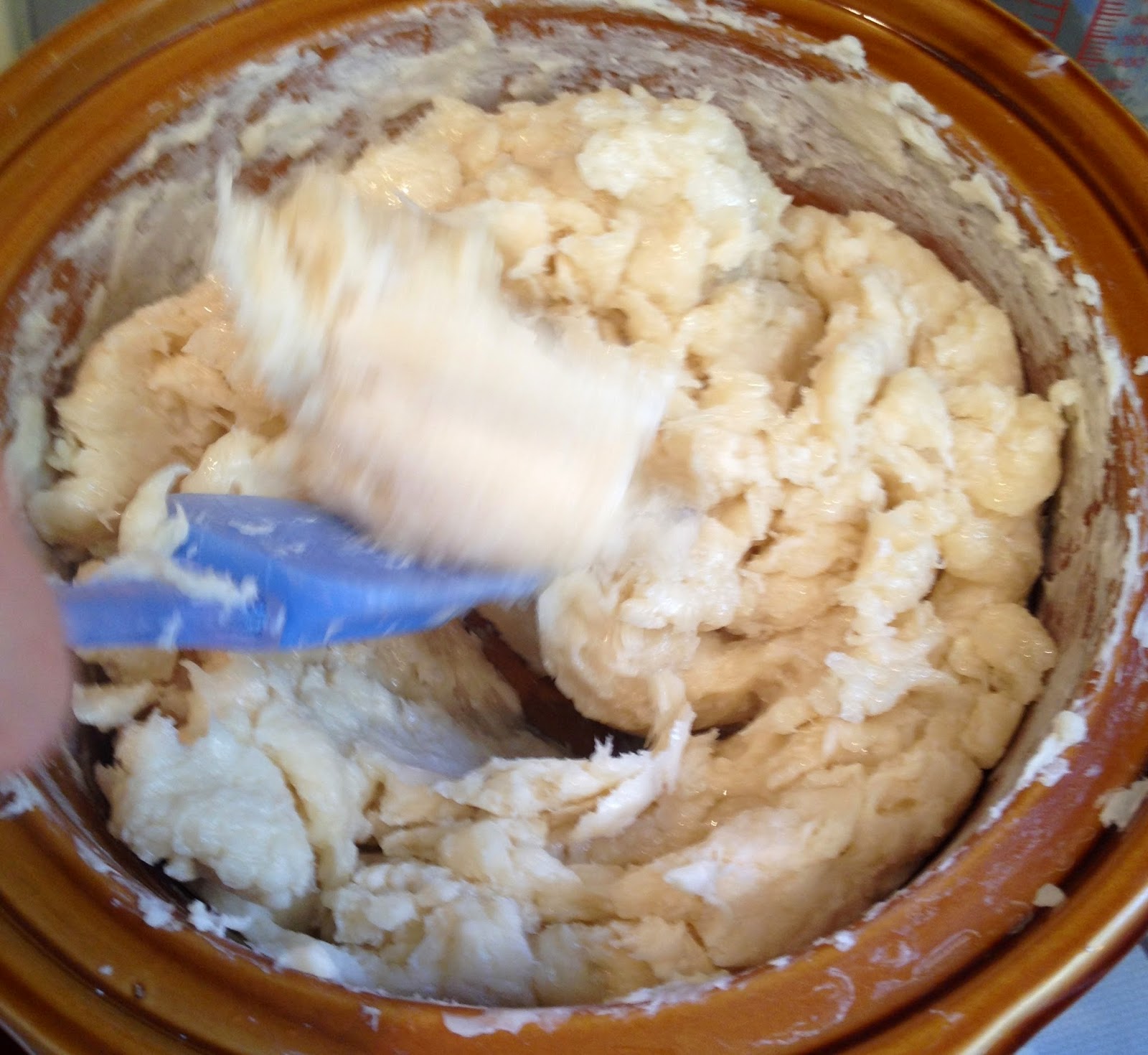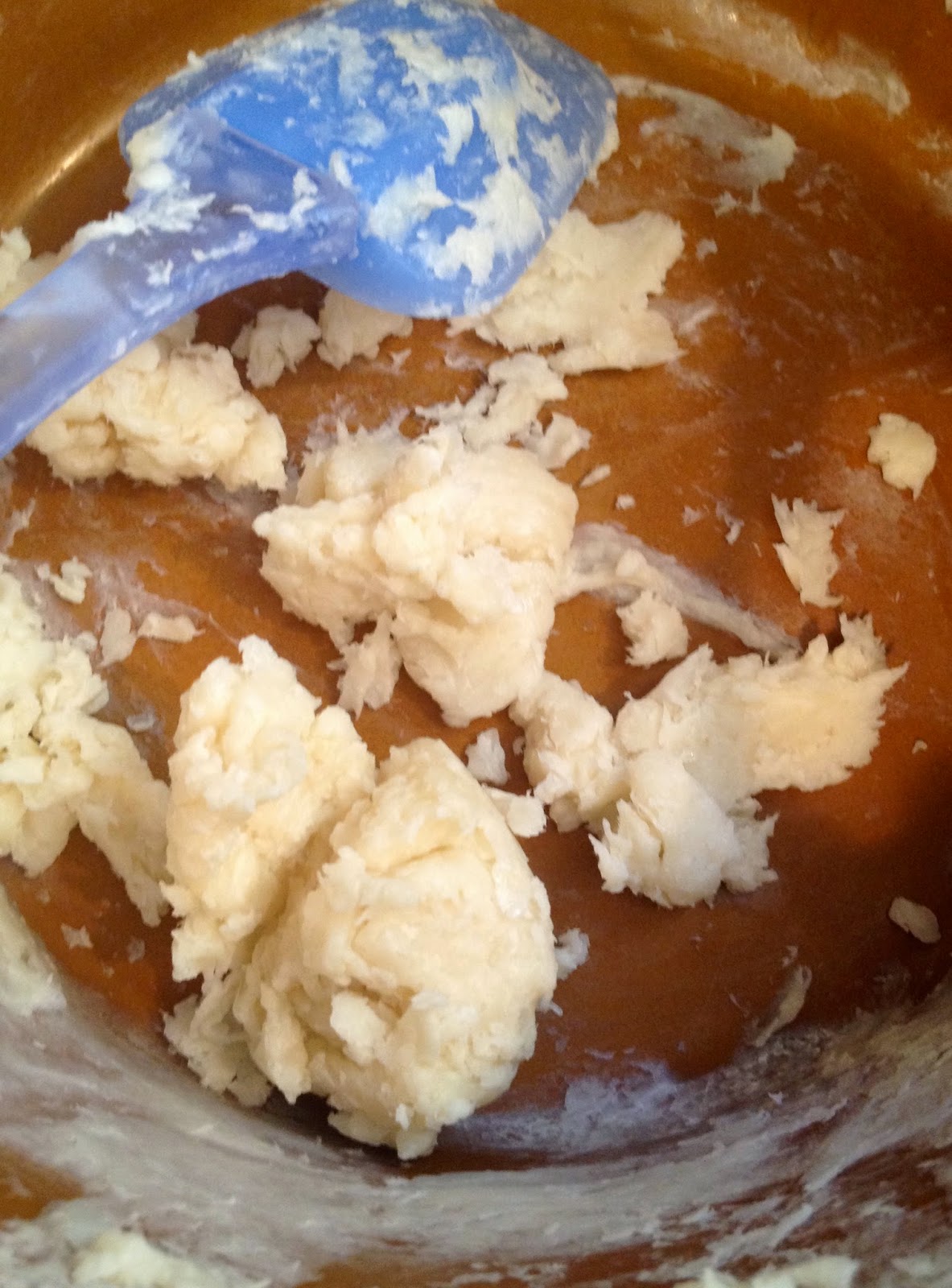Wednesday August 13, 2014
After the fun of our road trip yesterday, it was back to work today. We first had our typical discussion about what to make, then we decided on a batch of HP (hot process) soap to practice a design technique that we need to use for a special order.
Somewhere, somehow it did not go as planned. Do you ever have days like that? We aren't sure yet what might have been the root cause, but following is the rundown.
We decided to use a wonderful scent from +Natures Garden called Amazingly Grace, they describe the scent as follows: Italian bergamot and sparkling lemon are sweetened with freshly picked citron and neroli. A white floral jasmine, orange blossom and rose are blended with sheer musk and cedarwood. Let us just say the scent is "amazingly" nice.
We decided to add silk to this soap, and thought that cutting it up in smaller pieces should help it dissolve faster in the lye.
You can see the silk we had just added to the lye & water. Alison stirred it about 10 minutes until it was dissolved. We have used the silk in CP soap, but not in HP. In trying to figure out what happened with today's batch, could it be that it was using silk in HP? We aren't sure.
This is the mostly dissolved silk in the lye/water. If you look closely you can see small particles of the silk in the liquid.
We want a particular color for our special design so we are using Aqua Smoke mica colorant from +Bramble Berry, and it looks like a perfect match. We worked out a design plan that would place the mica-colored part of the soap exactly where we wanted it for a logo stamp.
We added the lye/silk liquid to the "old faithful" combination of oils, palm, coconut, olive and Castor.
We want to keep the batter as light as possible, so we added TD mixed with water. We usually mix the TD with oil, so maybe this was the problem. We hope not, though, because usually it is very difficult to get all of the lumps out of the TD when we mix it with oil. Today, when we mixed it with water, there were NO lumps!
We began mixing with the stick blender, and the batter seemed to stay very loose for quite a while. Was it because we'd added water to mix the TD? Was it because it was hot, remember it is in a crock pot. This time we pre-melted the coconut and palm oils in the microwave, where normally we let them melt on their own in the crock pot. Could this be the problem? Could it be the silk? Surely not since it is commonly added to the lye/water which gets very hot anyway.
Over five minutes had passed and I took over on the stick blending. Suddenly the batter seemed to feel thicker, then boom, within 15 seconds it was like thick mayonnaise. This was new, kind of like going from zero to 150 mph in the blink of an eye.
The batter is quite thick at this point. We had decided to cover the crock pot and not touch it until it had fallen in on itself (as we have seen in various photos from people who believe in the "don't touch it" method).
There seem to be so many different soap making methods "out there." Some say that you should resist the urge to stir the batter when using the HP method; others say to stir it and keep it evenly mixed. We have subscribed to the regular stirring philosophy in the past, but we also experiment with other methods to see if something else works better. Should we have just stuck to our own method?
Since we are nothing if not impatient, at the thirty minute mark we peeked. We could actually hear the soap sizzling. In picture above you can see the bubbles around the side (remember the heat is more intense on the sides of the crock pot.)
The top was pliable, basically we couldn't stand it and decided to stir the batter. So much for our resolve not to touch it.
When we stirred, we discovered mashed potatoes already. Yikes! What happened to gel stage? Did we miss it? Did it occur during that first thirty minutes when we didn't look? Gel stage is extremely important, and we weren't sure if it had happened or not, great!
As we stirred and prodded the batter we both noticed that it was sticking to the sides, very much like our "normal" HP soap does when it has finished cooking. We did the zap test, in fact Alison put a chunk of soap in her mouth and chewed; it was fine (well, the soap was fine, we aren't always sure about Alison).
We did notice that the batter seemed drier than usual even though we had the additional water with the TD. We decided that it was time to add the scent, hoping that the additional oil would add some moisture to the soap.
Here is where we noticed something else strange. Even though we had cooked the soap on the low setting, when we put the thermometer into the batter, the temp immediately rose up to just over 200 F. First, we have to be careful not to exceed the flash point of our fragrance or essential oils, and Amazingly Grace has a flash point of 200F. Too hot to add the scent right now. But wait a minute! When we realized that the temperature was too hot for our scent, we realized that the batter doesn't usually get quite that hot when we use the low setting on the crock pot. Was something wrong with the crock pot? Is that why it cooked so fast and got so dry?
We removed the crock from the heat element and stirred for a couple of minutes then checked the temperature again. It was below 200F, so we added the Amazingly Grace scent, hopeful that the addition of liquids would help make the soap more pliable and less dry.
Actually it did neither, but the soap sure did smell great!
A few minutes later we noticed the soap was seriously drying out and not sticking together.
This is wrong.
Really. This is not supposed to be happening.
We decided to skip trying to color any part of this batch and just cram the dry soap into the mold to see what happens tomorrow. Obviously this soap is not going to work as our practice design.
We keep packing the soap in. We didn't even try pouring it, no way.
Wound up spooning it in the mold.
You can see how crumbly it was by this bit sitting on the top.
We will do a post mortem to try to determine the source of the problem. It is discouraging to make a batch then watch it crumble, but sometimes that is the nature of making soap.
Alison put on the heavy gloves (not because we were worried about lye, but because the soap was so darn hot!) and began packing the batter in as tightly as she could.
Another shot of our crumbly batter.
Things we did differently:
1. Added water to the TD rather than oil (we even ran the recipe back through soapcalc to see whether the extra water would affect the lye ratio)
2. Used Rice Bran Oil rather than safflower oil to mix colorant (but we didn't add the colorant, so that's a non-issue in this batch)
3. Added the silk to hot process batch (so far have only added to CP)
4. Heated the solid oils in the microwave to melt them rather than letting them melt in the crock pot
5. Stick blended a good 5 minutes then batter got hard immediately (that must have resulted from something in either the ingredients or the heat because we didn't blend longer by choice and we didn't choose for it to harden that suddenly)
6. Not stirring every fifteen minutes (Would just 15 minutes more without stirring make THAT much difference?)
7. Noticed that the crock pot got hotter than it usually does
As we began cleaning up we noticed the nice bubbles in the crock pot. At least we had that, oh and the terrific smell.
I grabbed a few crumbled bits and washed my hands, it was soap for sure.
Even more bubbles as we filled the crock up to wash. Who knows maybe tomorrow when we unmold the soap it will be fine. If not, we will shred it with the grater and re-batch it.
At any rate we won't be practicing our
color design with this batch of soap.
That much we know for sure.
24 Hours later, our fears have been confirmed, and this batch is a bust. It is just to hard and crumbly to use in its current state.
This is the last time you will see this soap. We are going to rebatch it and
post the results on another blog.
After extensive research last night, we have decided that the problem was the cook temperature. The batter was just too hot. Could it be that our 35+-year-old crock pot has seen finer days? We think so, and will be using a different one from now on.




























No comments:
Post a Comment